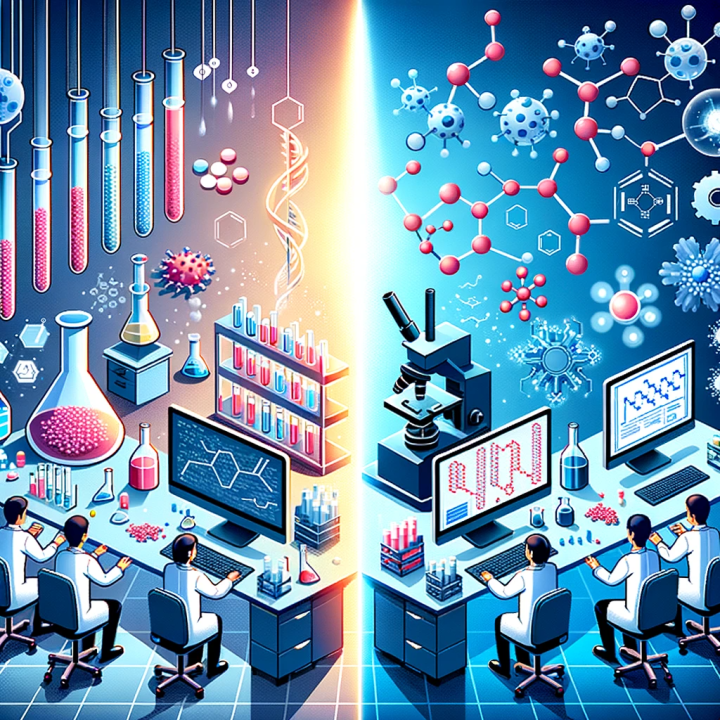The field of drug discovery has been transformed by in silico drug design, which utilizes advanced computational tools to predict, simulate, and optimize drug interactions with biological targets. This innovative approach has significantly reduced the time and costs traditionally associated with drug development. One of the major challenges in drug discovery is the high failure rate observed during clinical trials, often due to poor pharmacokinetics, insufficient efficacy, or high toxicity. A study by Wong et al., which analyzed 406,038 clinical trials conducted between 2000 and 2015, found that the overall probability of success for drug candidates was only 13.8%. By incorporating computer-aided techniques, researchers can better predict drug behavior, reduce the risk of failure, and accelerate the discovery process. Below, we explore the core principles, techniques, and real-world applications of in silico drug design.

Wiczew, L. (2024). In Silico Drug Design: Unveiling the Future of Medicinal Chemistry. LinkedIn. https://www.linkedin.com/pulse/in-silico-drug-design-unveiling-future-medicinal-chemistry-wiczew/
What is In Silico Drug Design?
In silico drug design uses computational simulations to model how drug candidates interact with biological targets such as proteins, enzymes, or DNA. This method is crucial in early drug discovery, helping researchers screen and prioritize compounds, optimize their molecular structures, and predict their efficacy before physical testing. According to Chang et al. (2023), in silico drug design involves key techniques like molecular docking, molecular dynamics (MD) simulations, quantitative structure-activity relationship (QSAR) analysis, and pharmacophore modeling.
Key Techniques in In Silico Drug Design
Molecular Docking: Molecular docking predicts how a small molecule (ligand) binds to a target, such as a protein. Docking algorithms simulate interactions, producing scores that reflect binding affinity. Pagadala et al. (2017) review popular docking programs such as AutoDock and Glide, which improve the accuracy of these predictions.
Molecular Dynamics (MD) Simulations: MD simulations complement docking by accounting for the dynamic behavior of ligand-receptor interactions over time, enhancing the understanding of drug stability in biological environments (Chang et al., 2023).
QSAR Models: QSAR models link a drug's chemical structure to its biological activity, helping optimize drug candidates by predicting potency and safety profiles (Lionta et al., 2014).
Pharmacophore Modelling: Pharmacophore models identify the essential structural features required for a drug to bind effectively to its target, guiding the design of more focused and effective drugs.
Applications of In Silico Drug Design
Accelerating Drug Discovery: In silico methods enable the rapid screening of vast compound libraries, allowing pharmaceutical companies to fast-track drug development. This approach reduces the reliance on time-consuming in vitro and in vivo experiments (Chang et al., 2023).
Targeting Specific Diseases: In silico techniques have been pivotal in designing drugs for cancer, neurodegenerative disorders, and infectious diseases like COVID-19. For example, molecular docking identified potential SARS-CoV-2 inhibitors during the pandemic (Lionta et al., 2014).
Personalized Medicine: By integrating genetic data with computational models, in silico drug design paves the way for personalized medicine, tailoring treatments based on individual genetic profiles (Chang et al., 2023).
Drug Repurposing: In silico tools allow researchers to repurpose existing drugs by predicting their efficacy against new disease targets, a strategy that has proven useful during health emergencies.
Reducing Side Effects: Molecular docking and QSAR models help identify compounds with minimal off-target effects, enhancing drug safety by predicting adverse reactions before clinical trials (Pagadala et al., 2017).
Conclusion
In silico drug design continues to revolutionize the pharmaceutical industry, offering faster and more cost-effective routes to drug discovery. Techniques like molecular docking, MD simulations, and QSAR modeling have become indispensable, shaping the future of personalized medicine and drug repurposing. As computational tools evolve, their role in drug development will only expand.
References
Chang, Y., Hawkins, B. A., Du, J. J., Groundwater, P. W., Hibbs, D. E., & Lai, F. (2023). A Guide to In Silico Drug Design. Pharmaceutics, 15(1). https://doi.org/10.3390/pharmaceutics15010049
Lionta, E., Spyrou, G., Vassilatis, D. K., & Cournia, Z. (2014). Structure-based virtual screening for drug discovery: principles, applications, and recent advances. Current Topics in Medicinal Chemistry, 14(16), 1923-1938.
Pagadala, N. S., Syed, K., & Tuszynski, J. (2017). Software for molecular docking: a review. Biophysical Reviews, 9(2), 91-102.
Singh, N., & Warshel, A. (2010). Absolute binding free energy calculations: On the accuracy of computational scoring of protein–ligand interactions. Proteins: Structure, Function, and Bioinformatics, 78(7), 1705-1723.
Wong CH, Siah KW, Lo AW. Estimation of clinical trial success rates and related parameters. Biostatistics. 2019 Apr 1;20(2):273-286. doi: 10.1093/biostatistics/kxx069. Erratum in: Biostatistics. 2019 Apr 1;20(2):366. doi: 10.1093/biostatistics/kxy072. PMID: 29394327; PMCID: PMC6409418. Assessed and Endorsed by the MedReport Medical Review Board
